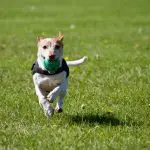Basic lessons every dog must learn
Here are 3 essential steps to teaching your dog basic social and pack etiquette, helping them to become better pets and good canine citizens.
You need to practice the steps given here for at least 10 minutes each day to help your dog master them. Stay consistent, even if you aren’t actively training make sure that your dog obeys the rules at all times.
The Human is the Leader
You are the leader, so start leading! You must be the one to decide when it’s time for something to happen, and that includes any kind of activity with your dog. Do NOT let them decide for you! Ignore attention seeking behavior like nosing to be petted or to play.
If you look at your dog when he requests attention than he wins, he has made you respond and that is a point towards his dominance. You MUST ignore him even if he’s being very silly in his attempts to win your attention. If you even smile a little bit, he will win!
Practice: Your dog comes up and noses you for attention. Ignore him. When he gives up and starts to walk away than call him back by using his name and the command “come”.
Give him lots of praise and love for coming when called. That way you are in charge, you are telling him that you will decide when it’s time to cuddle, and at the same time you are giving him the attention that he needed. Always, always, always obey this rule and you’ll be doing well in establishing your leadership.
Doorway and Stairway Etiquette
Having your dog charge through doorways or past you on the stairs, with little respect for you or what you might be carrying, is a bad thing.
Leaders always go first in the pack, so if your dog is charging through the door, he is considering himself the boss and that has to stop.
If you have a puppy, then you’ve hopefully already started learning the sit/stay commands, those will come in handy here.
Practice: Think of a place where you want your dog to stay until you have opened the door and stepped outside. I have a rug near my door, and that is the “stay” location. Your stay location should be within the range of your leash if you step outside the door.
Put on your dog’s training collar and leash, and walk him to the door. If he’s like most dogs he’s going to get really excited, probably start wiggling and whining and nosing the door in anticipation. Place him in his “stay” location and wiggle the doorknob. If your dog tries to move out of his stay position you must immediately correct him with a forceful “BAH!” or whatever your correction sound is.
Jiggle the doorknob again, and correct again if necessary. Practice until he no longer tries to break position if you jiggle the doorknob, then step up to opening the door. If he breaks position when you open the door, shut it quickly and correct him firmly. Continue to repeat this exercise until he stays in position with the door wide open.
Once you can stand with the door wide open and your dog remains in position, step just outside the door, holding the leash incase he bolts forward. If he breaks position to follow you, correct him firmly and put him back into position. Practice going through the doorway and keeping your dog in stay position.
When you can open the door and step outside with your dog staying in position, you can release him from his position by calling “free!” or “release!” whichever word you feel most comfortable with. This lets the dog know that he is free to now follow you out the door.
The same process should be used for stairs. Make your dog wait at the bottom of the stairs until you have reached the top, then tell him “free!” or “release!”.
The same is true for going down the stairs, through boundary gates, yard gates; anywhere the passage is narrow and signifies a separation between one area and another.
Just following these first two rules you’ll see a dramatic improvement in your dog’s attitude as he begins to feel safe and secure, knowing that you will take care of everything.
Walking on a Leash
It’s surprising how many people are daily teaching their dogs to be the leader during the afternoon walk. How you walk your dog is very important in establishing pack leadership.
If you watch a pack of wolves in the wild, you’ll see that the leader always decides when and where the pack is going, and the rest of the wolves follow behind. None of them would even dare consider trying to walk in front of the leader. They know that’s not allowed. Your dog should always walk at your side or behind you, never ahead of you.
This is a vital lesson for every dog, even if you want your dog to be a guardian or protector.
It’s absolutely necessary that they take their cues from you and don’t act on their own. They should be relaxed and calm, watching your body language for the correct response for every situation.
If you are calm and relaxed, they know that there is no danger and they can be calm and relaxed. If you suddenly become tense or frightened, they will know to be wary. If you are attacked or threatened, they will respond by defending you.
Using these lessons will strengthen the bond between you and your pet making them a better dog in every situation. You will not have to fear them biting or attacking another dog or person, because they will see from your body language that there is no threat so they must remain calm also. Yet if there is an emergency they will understand the difference in your body language and respond accordingly.
Dogs absolutely require stabile pack leadership or they will be confused and unsure of how they should respond in new or different situations, often resulting in poor or even fatal mistakes!
Practice: Using your training collar and a good leash take your dog out for a walk by placing him at your side and commanding “heel!”. Step forward and allow your dog to follow you. Imagine that there is a wall from your legs extending out sideways in front of your dog. Your dog’s shoulder should never surge ahead of this wall.
The lead should always be held long and slack unless you are correcting the dog. If your dog attempts to surge past you immediately snap the leash back, correcting him with a loud forceful “BAH!”, and loosen the lead again. It should be one quick motion. The leash pulls him sharply back into position, a loud vocal correction explains his error, then the leash is released showing him that he is now once more in the correct position.
You can make the correction stronger by giving him a foot of slack leash before sharply snapping him back into position. If you’ve been practicing the first two lessons at home, it will be easier for him to release that your leadership extends beyond the boundaries of the house, and he should learn quickly.
Watch his body language to see where his thoughts are. If his head is in a low relaxed position and his tail swinging low behind him, he’s learning. Particularly observe his ears and watch to see if one or both of them flicks back to check on your position every few seconds. That’s an excellent sign that he is recognizing you as leader and taking care not to move too far ahead!
If his head and tail abruptly jerk upwards towards another dog or other distraction, immediately correct him and snap him back into position. He should be paying attention to you and watching you for cues, not watching other dogs.


